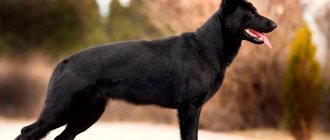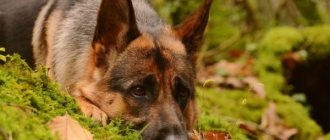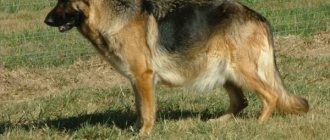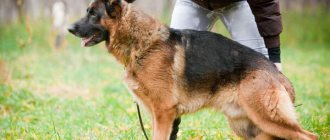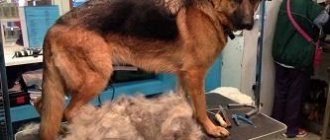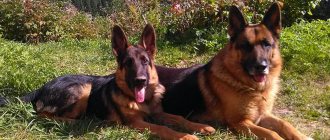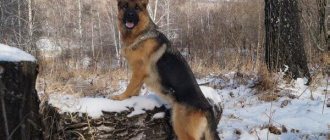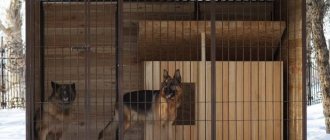The Czechoslovakian Wolfdog is a dog breed that is rightfully considered universal. Czechoslovakian breeders were involved in breeding the dogs; the work was carried out in the mid-20th century. It was possible to obtain this breed thanks to bold experiments. Breeders crossed an ordinary dog with wolves. The Czechoslovakian Wolfdog differs from other dog breeds in its strong immune system, developed intelligence, independence, and endurance.
History of the origin of the Czechoslovakian Wolfdog breed
Military operations required dogs that could combine the working qualities of a German shepherd and a Carpathian wolf. This work fell on the shoulders of Czech breeders. They decided to crossbreed 48 shepherd dogs and 4 wolves. The result of this work was the birth of the Czechoslovakian Wolfdog, which was distinguished by its bright temperament, pack instinct, lightning-fast decision-making, and the ability to quickly learn new things.
After some time, the wolf breed of dogs began to be actively used not only in military operations, but also in search and rescue activities, protective and guard activities. In addition, dogs often took part in hunting. Gradually, animals found their use in sports - towing, agility, obedience.
The year 1982 was significant. It was at this time that the Czechoslovakian wolf breed was officially recognized as national. After 17 years, the dogs were recognized by the International Canine Federation. During this period, the popularization of the breed began; animals began to spread to other countries around the world.
Czechoslovakian Wolfdog breed description
The Czechoslovakian Wolfdog differs from other breeds in its rectangular body shape and strong build, as a result of which the dogs can work and run for a long period of time. In appearance they resemble wolves. In addition, they have a similar coat structure, color, and the presence of a specific mask, which is not typical for dogs.
The Czech Shepherd is quite temperamental, sociable, but unobtrusive, and inquisitive. They are more distrustful of people, but behave with restraint in their company. Dogs differ depending on their gender. The differences affect only the appearance; this does not affect the character in any way.
Males can reach a height at the withers of up to 70 cm, weight about 26-30 kg. Smaller females: height about 65 cm, weight from 20 kg.
Size and appearance
The Czechoslovakian wolf breed is distinguished by its impressive size and proportional body. At the same time, the appearance resembles a wolf. From birth, dogs have strong teeth and developed muscles. Despite their large size, the dogs look harmonious and move easily.
The head has a proportional shape, its appearance more like a wedge with a blunt end. The frontal groove is practically not expressed, but the tubercle on the back of the head is clearly visible.
The eyes are small, the nose is oval. The lips are tight, there are no pockets. There is a straight and scissor bite. There are brown, black and multi-colored eyes.
The ears are triangular in shape, small in size and quite thin. If you look closely at the animal, you will notice that the upper corner of the eye is at the same level as the outer edge of the ear.
Thanks to its long neck, the dog is able to reach the surface of the ground with its nose.
Limbs are strong and muscular. The front paws are set close, you can see that the paws are slightly turned out. The hind limbs are parallel.
Attention! At exhibitions these breed standards are taken into account. The reason for disqualification is not only deviations from them, but also excessive cowardice or aggression of the animal.
Lifespan
This breed of dog differs from other animals by its maximum similarity to its ancestors - wolves. They have not only a bright appearance, but also a serious character. This breed, despite its small number, is known throughout the world. In the Czech Republic, laboratory tests are regularly carried out, the purpose of which is to identify possible deviations in health. Only if the results are good, then the dogs are used for breeding. The average life expectancy is 14 years.
Character
If we take into account the description of the breed, then this breed can rightfully be considered unique. They differ in temperament not only from dogs, but also from wolves. It is recommended to breed only experienced breeders, as breeding requires certain knowledge and experience. In addition, the breeder must have a strong character and become a true leader. The owner is not only an authority, but also a leader.
If you create favorable conditions for keeping, the following character traits will appear:
- Dogs are devoted to their owner and the property they protect. In case of danger, they are capable of sacrificing their own life.
- A characteristic feature is courage. In times of danger, the wolf does not take into account the number and size of the offenders; he rushes to defense, showing wolf ferocity.
- Thanks to its developed intelligence, the reaction manifests itself with lightning speed even in extreme situations.
- An integral character trait is endurance. Dogs are able to cover distances of up to 100 km without ever stopping to rest.
- Natural hunting instincts affect the fact that animals are actively used for hunting.
- Despite their genetic predisposition, they get along well with other pets.
In addition, representatives of this breed are no strangers to the joys of a dog; they also enjoy attention, care and love from their owner.
Attitude towards others
The Czechoslovakian Wolfdog breed is perfect for experienced dog breeders, as a beginner is unlikely to be able to cope with it. With other pets - cats and dogs, wolves have different relationships. However, if the animals grew up together from an early age, then emotions towards each other will be extremely positive.
The wolfdog is characterized by leadership qualities, so the owner must build the correct hierarchy from the first days. It is the owner who must become a leader, authority, leader for the dog. Dogs are distrustful of strangers. It is impossible to bribe them even with the most delicious delicacies - the dog is always faithful to its owner.
Attitude towards children
If you plan to bring a wolfdog into your family, then you should understand that he will be wary of new family members. They take a very long time to get used to, and often do not accept the person at all. Therefore, if you plan to have children, it is important to remember that the baby may not be accepted by the dog.
They try to show tolerance towards children, but they do not like to be treated rudely or familiarly. In addition, they consider children to be creatures of a lower rank, so they do not feel much love or respect. Thus, the Czechoslovakian wolfdog breed is not recommended for families with small children.
Intelligence
As the dog grows older, it begins to change, and along with it, its character and intelligence change. This breed has developed intuition, thanks to which dogs can understand the mood of all family members, especially the owner. If a dog senses that a person is upset, he will definitely come over to comfort him. In case of happiness, the dog tries to imbue him with the same feeling. If a person is not in the mood for contact, then they will never impose their communication. Quite proud and independent. Without communication, dogs become aggressive and suspicious.
Character
Despite its appearance, the Saarloos wolf dog is not aggressive. However, she has several traits inherited from her ancestor.
First of all, it is timidity and distrust of strangers. Then there is a strong pack instinct, they perceive a person as the leader of the pack.
And a strong will, unwillingness to obey someone of lower rank.
These qualities lead to the fact that to successfully keep a wolf dog you need two things - the strong character of the owner and his understanding of the psychology of dogs.
In addition, socialization is extremely important, getting to know other dogs, people, smells, and impressions.
With proper training, a wolf dog can be successfully kept both in an apartment and in a private house. But it would be better if it was a private house with a spacious yard. They are energetic and curious dogs that can forget about everything when following an interesting scent.
Because of this, when kept in a yard, it is necessary to surround it with a high fence, since they are able to jump quite high and dig well.
It is easy to guess that the Saarloos wolf dog has a well-expressed hunting instinct and, without proper training, they will pursue small animals.
In the family circle, they are relaxed and calm, forming close bonds with all family members.
However, children may be perceived as inferior and dominated. It is important to establish a hierarchy in which all family members occupy a dominant role.
And carefully monitor the relationship between the dog and the child. In any case, do not leave children unattended, even if we are talking about decorative dog breeds.
The breed is characterized by a very wary attitude towards strangers, but instead of barking or aggression, they try to hide. Which makes them poor watchdogs.
In addition, they avoid small children, as they are too energetic and restless. All this makes the socialization of the dog extremely important, and not every owner knows how to socialize correctly.
Add to this the tendency to live in a pack, which means that they do not tolerate loneliness and boredom well. It is advisable for owners to keep several dogs so that they do not get bored even when they are away.
The Saarloos Wolfdog is not for beginners! Understanding the psychology of a dog, its pack instinct, the ability to control it, socialize it - all this is extremely rare among those who get a dog for the first time.
Education and training
The Czechoslovakian wolf breed can be trained, but this will require a lot of effort and patience. It is important to remember that the dog is quite complex. Since the dog is not only emotional, but also smart, it will constantly look for ways to outwit its owner and disrupt training. In this matter, the most important thing is persistence, firmness of intentions and character. The Czechoslovakian Wolfdog should under no circumstances set the rules.
During training, it is recommended to adhere to the basic rules:
- Keep yourself in control. It’s not the best option to raise your head at the dog and take out your anger on her.
- Don't panic. The owner is the leader of the pack, who can always control the dog. When panic appears, the pet will immediately feel it, after which trust will disappear completely.
- Do not harm the animal. Any cruelty to a pet is prohibited, otherwise aggression cannot be avoided.
- Encouragement. It is recommended to reward the Czechoslovakian Wolfdog for obedience. You can use more than just treats for this. The dog will be pleased to hear praise from the owner.
If you follow these rules, then there will be no problems during education and training.
Advantages and disadvantages
Tops have the highest degree of affection for a person, his family and habitat. Animals dislike being alone so much that they fall into a state similar to fear, which in turn develops into rage. This is far from a cute pet. Without a doubt, a dog of this breed needs training more than any other breed, since the wolfdog exhibits natural instincts more than other breeds. And even if your pet understood the second time how to go to the toilet on the street, and immediately after that began to ask for a walk, this does not mean that you can be conniving towards the animal and stop training there. Did you know? The main thing in raising a Czech Wolfdog is not to lose vigilance, to be always on the alert and ready for any situation. A properly raised and properly socialized dog brings a lot of joy to its owner. You should also not forget about personal responsibility when a half-wolf is raised in the house, especially if children are growing up in the family.
THE HORTA BORZOI IS, WITHOUT A DOUBT, ONE OF THE BIGGEST PRIDES OF RUSSIA CYNOLOGY
HOVAWART IS NOT ONLY AN EXCELLENT GUARDIAN, BUT ALSO A FUN, CUTE COMPANION
BOUVIER OF FLANDS (FR. BOUVIER DES FLANDRES BOUVIER DE FLANDRES) - CHEEP DOG FROM FLANDERS
FINNISH SPITZ (FIN. SUOMENPYSTYKORVA, ENG. FINNISH SPITZ) HUNTING BREED OF DOG
Health and diseases of the Czechoslovakian Wolfdog
The Czechoslovakian Wolfdog has a fairly strong immune system. Thanks to the high-quality work of breeders, this breed of dogs does not have genetic diseases. However, despite the fact that animals are hardy, they have weaknesses. Thus, in the process of life, diseases associated with the musculoskeletal system appear. The most common condition is hip dysplasia.
According to veterinarians, diseases appear in dogs for the following reasons:
- Incorrectly formulated diet.
- There is a calcium deficiency.
- The dog has little physical activity.
- Injuries in animals were treated independently or untimely.
- Slippery finish floor covering.
Important! The diagnosis should not be considered a death sentence. Any disease can be cured. But this requires understanding that it will take a lot of time, effort, and money.
Breed standard
Outwardly, this animal looks more like a wolf than a dog. She has a rectangular build, a strong wide back, and a medium-length neck. The withers are well developed. The lower back sticks out a little. Well developed sternum. The tail is carried high and hangs down, but when the dog is excited it can become erect. FCI standard for Czechoslovakian Wolfdog.
This is a wiry, massive dog that has excellent physical potential. It grows up to 65 cm at the withers, gaining weight up to 27 kg.
The wolfdog's paws are placed symmetrically, with the hind legs slightly turned outward. Long arched fingers. Very powerful muscles of the pelvis and hips. Thanks to this, the dog pushes off strongly from the ground, making a long jump, and can also quickly increase speed.
Breed standard Czechoslovakian Wolfdog FCI
It has a large head with an elongated muzzle. At its tip there is a large dark nose, the nostrils are wide. Black gums are visible from the mouth. The bite of the teeth is scissor-shaped. The eyes are almond-shaped and bright. The ears are thick, located on the top of the head at a short distance from each other.
The Wolfhund's coat is lush, straight, and medium in length. The interesting thing is that in winter it becomes thicker. This feature is characteristic of wolves, but the representative of the breed in question inherited it. The thick and lush undercoat warms him at low temperatures, preventing him from feeling the cold.
Possible colors:
- Grey.
- Grey-white.
- Yellow-gray.
- Reddish.
- Red and white.
A high-breed Czechoslovakian Wolfdog must have a light “mask” on its face.
Care and maintenance
If a Czechoslovakian wolfdog lives in your home, then you should take care of proper care and maintenance. As practice shows, dogs can cope with many things on their own, but control will not be superfluous.
- Walking. Walks must be mandatory, long and daily - at least 2 times a day. The socialization of the dog deserves special attention. To do this, it is recommended to take the puppy to crowded places from the first months. The dog must get used to the noise and behavior of people. When walking, you should use a muzzle and harness.
- Bathing. This event is not required for your pet. The Czechoslovakian Wolfdog has a coat that does not get dirty. If necessary, you can give your dog a bath; they are not afraid of water; on the contrary, they will even support such an idea.
- Ear cleaning. According to the recommendations of dog handlers, it is recommended to clean the ears once every month in the winter, and in the summer the procedure is carried out every 2-3 weeks.
- Combing. Molting occurs twice a year and is intense. During this period of time, almost all of the undercoat falls out. If necessary, this process can be accelerated - water procedures are enough. Thanks to such procedures, it is possible to prevent the appearance of tangles.
- Claw care. It is not necessary to trim the dog’s claws, as he can handle this on his own. All that is required is to provide walking on different surfaces.
- Dental care. It is recommended to brush your teeth regularly. Veterinarians carry out similar procedures.
Diet
In order for the dog to grow and develop properly, you should adhere to the recommended feeding frequency: up to 4 months – 4-6 times a day; up to 6 months – 3-4 times; up to a year – 2 times; from one and a half years - once a day. As for the diet, preference should be given to natural products. Serving size should be approximately 2-3% of body weight. 70% is meat, offal and meat and bone products, about 10% vegetables and 20% porridge. From time to time, the menu is supplemented with fish, eggs and dairy products. Vitamin and mineral supplements are given as needed, usually in courses every season. Many owners switch their dogs to ready-made dry food, but this option is considered less suitable.
Application
As already mentioned, this breed of dog was actively used for military operations. However, thanks to their intellectual abilities, dogs began to be used in other sectors of life. Vlchars have proven themselves better than all other dogs in search and rescue operations, during hunting and searching for prey.
In addition, dogs do an excellent job of guarding and protecting livestock. They show devotion to the pack and fearlessness. Good immunity and endurance affected the fact that the animals began to be used as sled dogs, which is very popular in their homeland. Today, wolfdogs are bred to protect people and protect personal property.
Advantages and disadvantages
Perhaps the most important disadvantage of the breed is controllability, which dogs practically do not lend themselves to. Neither the work of breeders nor dog handlers have so far been able to make the breed obedient. Moreover, if you remember the size of animals, it is easy to imagine what danger they can pose to others.
Other disadvantages include:
- Complete independence.
- Uncontrollable.
- If the owner is gone for a long time, then severe aggression begins to appear.
Advantages of the breed:
- Dogs are quite loyal; if necessary, they are ready to sacrifice their own lives to save their owner.
- Developed intellectual abilities, thanks to which dogs make decisions as quickly as possible in case of danger.
- Brave.
- Hardy.
- They have high security and watchdog abilities.
- Dogs are incorruptible; they will not take food from the hands of a stranger, even if they are very hungry.
- Sociable, but not intrusive.
It is important to remember that the Czechoslovakian Wolfdog is independent and strong, and only a true leader with a strong character can cope with it. Such breeds are not recommended for beginning dog trainers.
Advice! Families with children are prohibited.
How to choose a Czechoslovakian Wolfdog puppy
This dog breed is not very common. Few people would dare to breed such wayward and strong dogs. It is for this reason that the price for them is quite high - from 60 thousand rubles.
It is recommended to buy dogs through kennels. It is strictly forbidden to do it by hand, since it is extremely difficult for dogs to get used to a new owner and family, and it can be extremely difficult to cope with him.
Price
You can purchase this wonderful four-legged friend from private breeders or in a nursery. We recommend choosing the first method.
In the Moscow region there is the village of Malakhovka. It is there that high-breed Czechoslovakian Wolfdogs are bred for sale. But, if you dream of becoming the owner of this beautiful dog, which would fully comply with the international breed standard, then you will have to go to a Czech kennel for him.
The price of a Czechoslovakian wolfdog is from 45 to 75 thousand rubles. There is a cheaper option for purchasing – “from hand”. But, in this case, you will not be provided with a pedigree and a passport for the puppy. The cost of selling it to private owners is from 10 to 20 thousand rubles.
